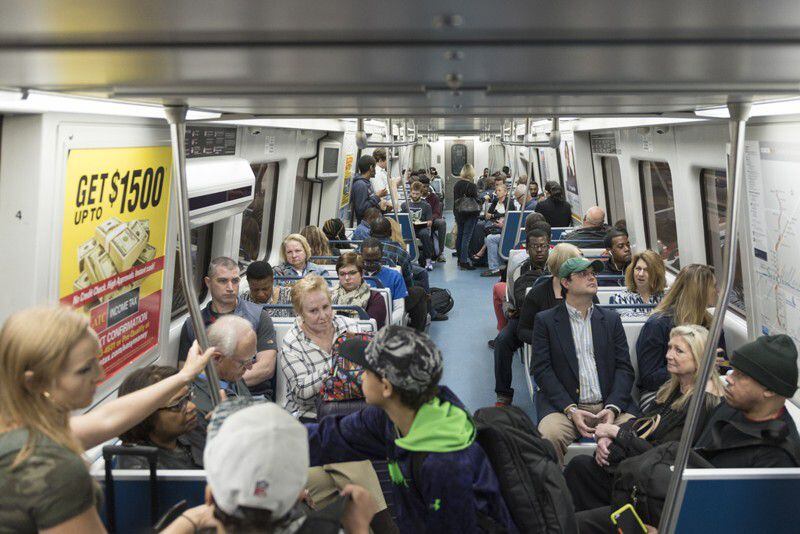When the I-85 bridge collapsed this spring, MARTA increased service and staffing to win over commuters forced off Atlanta highways and onto its trains.
But an Atlanta Journal-Constitution analysis of federal transit statistics suggests MARTA got only a small boost in ridership that didn’t last. In fact, ridership on the system’s trains and buses is down more than 2 percent this year – part of a long-term decline that has only occasionally been interrupted by fits of growth.
The decline in riders mirrors a national trend. Experts say transit ridership across the country fluctuates but has been hit lately by everything from cheap gas to competition from ride-hailing services. MARTA hoped to buck the trend when I-85 gave it a chance to court new riders.
MARTA officials say it's too soon to know for sure whether a significant number of people stuck with public transportation after I-85 reopened in May. They say the transit system's limited service area and other factors have contributed to the long-term decline in passengers. But with expansion coming and recent efforts to improve service, they say the future looks bright.
“I think we are in the bottoming-out portion of a relatively long period of sustained decline,” MARTA CEO Keith Parker told the AJC. “I think there’s an optimistic future for us.”
Skeptics aren’t so sure. Benita Dodd, vice president of the fiscally conservative Georgia Public Policy Foundation, said it doesn’t make sense to expand MARTA when fewer and fewer people are using it.
“When you ask people, do they think we need transit, everybody will agree,” Dodd said. “Then you start asking how many will take transit. It’s rare. People hope that others will take it.”
The car-happy Atlanta region has long been ambivalent about mass transit. Though Fulton and DeKalb counties have had MARTA service for decades, voters in fast-growing Cobb and Gwinnett counties have repeatedly rejected it.
Attitudes have begun to change as new residents arrive from transit-friendly areas and companies like State Farm and Mercedes-Benz build along MARTA lines. The General Assembly – long hostile to MARTA – has taken steps that could eventually lead to state funding of mass transit.
So when I-85 collapsed on March 30 and remained closed for six weeks, MARTA saw a chance to reintroduce itself to thousands of commuters who usually ride solo on Atlanta's congested highways.
The agency increased the frequency of its trains, added staff and parking and otherwise rolled out a red carpet. The goal: Give the newcomers a good experience and make them long-term customers.
The AJC analysis suggests the effort hasn’t panned out.
Passenger trips on MARTA’s rail service were up 3.5 percent in April compared to the same month in 2016. But that gain in rail passengers was largely offset by a decline on buses, which were stuck in traffic with everyone else. Overall ridership – including trains, buses and paratransit service for seniors and the disabled – was up just .6 percent in April, the analysis found.
By May, when I-85 reopened, the spike appeared to be over. Ridership that month was down 3.1 percent from May 2016.
Carol Smith, MARTA’s director of research and analysis, said some new riders did stick with transit after I-85 reopened, though it’s too soon to know how many. She said the agency is surveying customers to find out.
But if MARTA retained some new customers, it wasn’t enough to offset the loss of others. For the first six months of 2017, MARTA ridership was down 2.1 percent, compared to the same period last year, the AJC’s analysis found.
That’s no fluke. Federal statistics show MARTA ridership declined nearly 12 percent from 2002 through last year.
At times, ridership has grown. The number of passenger trips rose from 2004 to 2008 as gas prices spiked. The cost of unleaded gas in Atlanta reached an all-time high of $4.11 a gallon in September 2008, according to AAA.
Ridership declined again during the Great Recession as MARTA cut service and raised fares. Then it rose again in 2014-15 – Parker said service improvements and a crackdown on bad behavior by some passengers lured more customers.
But Parker said cheap gas and rising car sales in recent years have once again cut into MARTA ridership. Passenger trips fell more than 5 percent last year, and ridership has continued to slide in 2017.
PHOTOS: LOOKING BACK AT MARTA
MARTA isn’t alone. According to statistics maintained by the American Public Transportation Association, an industry group, transit ridership nationwide fell more than 2 percent last year.
Kari Watkins, a civil engineering professor at Georgia Tech, said transit ridership is cyclical and influenced by the economy, population changes and gas prices. Competition from ride-hailing services also may be a factor, and more people may be walking or biking instead of taking mass transit, she said.
Still, Parker said MARTA is poised for a rebound. The agency is trying to create demand for its services by promoting development at its transit stations. He also cited fare promotions and efforts to improve customers' experience, like fresh-food markets at stations.
“We’re not resting,” he said. “We’re being aggressive.”
Parker said expanding the system is key to boosting its customer base in the long run. As Atlanta has grown, MARTA has not grown with it.
“The most legitimate criticism folks can render against our transit system is we don’t go all the places they want to go,” he said.
Expansion is on the way. Two years ago MARTA began local bus service in Clayton County and plans to launch a rail or high-speed bus service there in the future.
Last year Atlanta voters approved a MARTA expansion, though the specifics are being finalized. Fulton and DeKalb counties also are talking about expansions.
Dodd believes expanding the rail system is a mistake. With transportation technology changing rapidly, she said it amount to “expanding a technology that’s already on its way out.” She’d rather see the agency improve its bus routes and allow private companies to provide more service.
Experts say Atlanta needs a diverse transportation network to address existing traffic and accommodate the millions of additional residents expected to move here in coming decades. Watkins said Atlanta needs more transit corridors to give commuters options.
“We can’t build our way out of congestion, but we can build alternatives, so you don’t have to sit in (traffic),” she said.
MARTA ridership
MARTA ridership is trending down after two years of gains – despite a modest boost from the collapse of the I-85 bridge. The chart shows the number of annual passenger trips on MARTA rail, bus and paratransit service combined. The 2017 figures are for the first six months of the year.
*January through June compared to the same period in 2016
SOURCE: AJC analysis of data from the National Transit Database
About the Author







